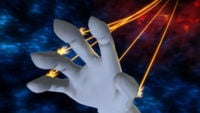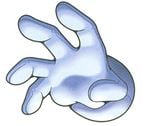Master Hand: Difference between revisions
(→Trivia) |
Time Turner (talk | contribs) (The last article with a biography section?) |
||
| Line 11: | Line 11: | ||
He is voiced by Jeff Manning in the original, Dean Harrington in [[Super Smash Bros. Melee]], and Pat Cashman in [[Super Smash Bros. Brawl]]. | He is voiced by Jeff Manning in the original, Dean Harrington in [[Super Smash Bros. Melee]], and Pat Cashman in [[Super Smash Bros. Brawl]]. | ||
== | ==History== | ||
{{spoiler}} | {{spoiler}} | ||
=== | ===[[Super Smash Bros.]]=== | ||
Master Hand first appeared in ''Super Smash Bros.'', where it supposedly gave several dolls based on [[Nintendo]] characters life and pitted them against each other.<ref>[http://www.youtube.com/watch?v=RSSXFU8jc0U Video of opening scene in ''Super Smash Bros''.]</ref> After each character defeats all challengers, they will be transported to the battlefield, the "[[Final Destination]]", where they will face off against the sinister appendage. After defeating the being, the player will revert to their original doll state. | Master Hand first appeared in ''Super Smash Bros.'', where it supposedly gave several dolls based on [[Nintendo]] characters life and pitted them against each other.<ref>[http://www.youtube.com/watch?v=RSSXFU8jc0U Video of opening scene in ''Super Smash Bros''.]</ref> After each character defeats all challengers, they will be transported to the battlefield, the "[[Final Destination]]", where they will face off against the sinister appendage. After defeating the being, the player will revert to their original doll state. | ||
<br clear=all> | <br clear=all> | ||
=== | ===[[Super Smash Bros. Melee]]=== | ||
Master Hand reappeared in the sequel to ''Super Smash Bros.'', ''[[Super Smash Bros. Melee]]''. This game introduced Master Hand's counterpart, [[Crazy Hand]], which is said to embody lust for destruction (the game also says that Master Hand embodies creation). The battle against the Master Hand in this game is nearly identical to the original ''Super Smash Bros.''; after defeating all opposition the player will face Master Hand in [[Final Destination]]. The only difference is that if the player clears all stages on Normal level or higher within 10 minutes and without using a continue, Crazy Hand will appear once Master Hand has lost half of his HP; as is in the original, once Master Hand (and sometimes Crazy Hand) is defeated the player will revert into a trophy, appearing among the trophies of others who have defeated the Master Hand. The Master Hand is a much more difficult enemy in Melee because his health increases as the difficulty goes up, and the times can't be turned off in single player anymore (if the timer runs out, then the player automatically loses regardless of health or number of lives). | Master Hand reappeared in the sequel to ''Super Smash Bros.'', ''[[Super Smash Bros. Melee]]''. This game introduced Master Hand's counterpart, [[Crazy Hand]], which is said to embody lust for destruction (the game also says that Master Hand embodies creation). The battle against the Master Hand in this game is nearly identical to the original ''Super Smash Bros.''; after defeating all opposition the player will face Master Hand in [[Final Destination]]. The only difference is that if the player clears all stages on Normal level or higher within 10 minutes and without using a continue, Crazy Hand will appear once Master Hand has lost half of his HP; as is in the original, once Master Hand (and sometimes Crazy Hand) is defeated the player will revert into a trophy, appearing among the trophies of others who have defeated the Master Hand. The Master Hand is a much more difficult enemy in Melee because his health increases as the difficulty goes up, and the times can't be turned off in single player anymore (if the timer runs out, then the player automatically loses regardless of health or number of lives). | ||
=== | ===[[Super Smash Bros. Brawl]]=== | ||
[[Image:MasterHandChain.jpg|thumb|'''Master Hand''' harpooned by Tabuu's Chains of Light.]] | [[Image:MasterHandChain.jpg|thumb|'''Master Hand''' harpooned by Tabuu's Chains of Light.]] | ||
Master Hand is featured in ''[[Super Smash Bros. Brawl]]''. Though it is never actually fought in the Emissary, it appears in Boss Battles Mode with the standard Emissary boss health bar. It also appears in its usual role as the last enemy faced in Classic Mode. Crazy Hand joins it under the same circumstances as in ''Melee''; however, unlike in Melee, Crazy Hand appears immediately at the start of the battle. | Master Hand is featured in ''[[Super Smash Bros. Brawl]]''. Though it is never actually fought in the Emissary, it appears in Boss Battles Mode with the standard Emissary boss health bar. It also appears in its usual role as the last enemy faced in Classic Mode. Crazy Hand joins it under the same circumstances as in ''Melee''; however, unlike in Melee, Crazy Hand appears immediately at the start of the battle. | ||
Revision as of 17:49, February 2, 2010
Template:SSB Infobox Master Hand is one of the main antagonists of the Super Smash Bros. series. The Master Hand is a right-handed, large, disembodied, glove-clad hand. In Super Smash Bros. it has a strange resemblance to one of Mario's gloves, though they appear less similar in later games.
It has been disputed as to what the Master Hand is; some say it is a god-like being with reality-warping power, while others say it is nothing more than a child with an overactive imagination playing with his toys (This assumption is strengthened by the fact that the hand is shown in a child's room and removing the dolls from a toy chest in the original Super Smash Bros).
He is voiced by Jeff Manning in the original, Dean Harrington in Super Smash Bros. Melee, and Pat Cashman in Super Smash Bros. Brawl.
History
Super Smash Bros.
Master Hand first appeared in Super Smash Bros., where it supposedly gave several dolls based on Nintendo characters life and pitted them against each other.[1] After each character defeats all challengers, they will be transported to the battlefield, the "Final Destination", where they will face off against the sinister appendage. After defeating the being, the player will revert to their original doll state.
Super Smash Bros. Melee
Master Hand reappeared in the sequel to Super Smash Bros., Super Smash Bros. Melee. This game introduced Master Hand's counterpart, Crazy Hand, which is said to embody lust for destruction (the game also says that Master Hand embodies creation). The battle against the Master Hand in this game is nearly identical to the original Super Smash Bros.; after defeating all opposition the player will face Master Hand in Final Destination. The only difference is that if the player clears all stages on Normal level or higher within 10 minutes and without using a continue, Crazy Hand will appear once Master Hand has lost half of his HP; as is in the original, once Master Hand (and sometimes Crazy Hand) is defeated the player will revert into a trophy, appearing among the trophies of others who have defeated the Master Hand. The Master Hand is a much more difficult enemy in Melee because his health increases as the difficulty goes up, and the times can't be turned off in single player anymore (if the timer runs out, then the player automatically loses regardless of health or number of lives).
Super Smash Bros. Brawl
Master Hand is featured in Super Smash Bros. Brawl. Though it is never actually fought in the Emissary, it appears in Boss Battles Mode with the standard Emissary boss health bar. It also appears in its usual role as the last enemy faced in Classic Mode. Crazy Hand joins it under the same circumstances as in Melee; however, unlike in Melee, Crazy Hand appears immediately at the start of the battle.
In the Subspace Emissary storyline, Master Hand makes its debut as the leader of the Subspace Army, commanding its loyal minions, Ganondorf, Bowser, and Wario. However, near the end, it is discovered that Master Hand was being controlled by Tabuu using the chains of light, in order to trick Ganondorf, Bowser, and Wario into drawing the entire world into Subspace. Angered, Ganondorf attempts to attack Tabuu, but is blocked by a force field and turned into a trophy upon smashing into Master Hand. This severs the strings holding Master Hand, and the hand tries to fight Tabuu, but is knocked to the ground by the force field, where it lies either dead or unconscious. It is interesting to note that when Master Hand is knocked out, it does not turn into a trophy as everyone else does. After Master Hand's possible death from Tabuu, it stays on the ground and isn't even acknowledged by the other characters.
Template:Endspoiler
Trophy Information from Super Smash Bros. Melee
| # | Name | Image | First Game / Move | Description |
|---|---|---|---|---|
| 83 | Master Hand | Super Smash Bros. 04/99 |
The Master Hand awaits anyone who survives the long and difficult road to the Final Destination. This symbolic link between the real world and the imaginary battlefields of Super Smash Bros. Melee is quite a handful in battle, and just because it wears a white glove doesn't mean it fights clean. Get ready to be flicked, swatted, punched, and poked like crazy! |
Trophy Information from Super Smash Bros. Brawl
| # | Name | Image | First Game / Move | Description |
|---|---|---|---|---|
| 128 | Master Hand | File:MasterHand.jpg | N64 Super Smash Bros. WII Super Smash Bros. Brawl |
A being tied to the link between this world, where trophies fight, and the world beyond. The meaning of his existence is unknown, as are his goals, but he seems to have obtained (and kept hidden) a power that borders on absolute. He also seems to feel a certain joy in challenging chosen warriors who've claimed many victories. He waits even now in Final Destination. |
Trivia
- In Kirby & the Amazing Mirror, Master Hand is a mini-boss throughout the game. Once defeated, Kirby can eat him and become Smash Kirby (He can use all of Kirby's special attacks from Melee). Master Hand also appears later in the game as a Boss along side Crazy Hand.
- In France, Master Hand is called Créa-Main.
- He always has the same voice as the announcer in SSB games. This suggests that Master Hand himself is the announcer for the games.
- Using an Action Replay, the player can hack the game and be able to play as Master Hand.
- In Super Smash Bros. Melee, Master Hand is considered genderless, based on his trophy. However, his trophy in Super Smash Bros. Brawl does refer to him as a male.
References
| Super Smash Bros. | ||||
|---|---|---|---|---|
| Playable characters | Donkey Kong • Fox • Kirby • Link • Luigi • Mario • Samus • Yoshi • Others | |||
| Non-playable characters | Bob-omb • Whispy Woods | |||
| Bosses | Giant Donkey Kong • Metal Mario | |||
| Stages | Peach's Castle • Yoshi's Island • Congo Jungle • Hyrule Castle • Meta Crystal • Mushroom Kingdom • Others | |||
| Items | Barrel • Bob-omb • Crate • Egg • Fire Flower • Green Shell • Hammer • Red Shell • Star • Star Rod • Target | |||
| Moves | Miscellaneous | Jump • Taunt | ||
| Special | Standard | Up | Down | |
| Mario | Fireball | Super Jump Punch | Mario Tornado | |
| Luigi | Green Fireball | Luigi Cyclone | ||
| Donkey Kong | Giant Punch | Spinning Kong | Hand Slap | |
| Yoshi | Egg Lay | Egg Throw | Yoshi Bomb | |
| Other | Gallery • Glitches • Pre-release and unused content • Quotes • Smash Card • Super Smash Bros. Poll • Super Smash Bros. (Shockwave game) • Staff | |||

